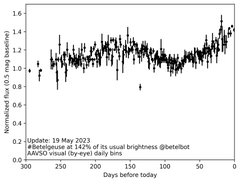Star Betelgeuse's Spectacular Supernova Will Be Visible With the Naked EyeStory by Jess Thomson • 5h ago
Newsweek NASA four-panel graphic illustrating how the southern region of the rapidly evolving, bright, red supergiant star Betelgeuse may have suddenly become fainter for several months during late 2019 and early 2020. In the first two panels, as seen in ultraviolet light with the Hubble Space Telescope, a bright, hot blob of plasma is ejected from the emergence of a huge convection cell on the star's surface. In panel three, the outflowing, expelled gas rapidly expands outward. It cools to form an enormous cloud of obscuring dust grains. The final panel reveals the huge dust cloud blocking the light (as seen from Earth) from a quarter of the star's surface. NASA, ESA, and E. Wheatley STScI
NASA four-panel graphic illustrating how the southern region of the rapidly evolving, bright, red supergiant star Betelgeuse may have suddenly become fainter for several months during late 2019 and early 2020. In the first two panels, as seen in ultraviolet light with the Hubble Space Telescope, a bright, hot blob of plasma is ejected from the emergence of a huge convection cell on the star's surface. In panel three, the outflowing, expelled gas rapidly expands outward. It cools to form an enormous cloud of obscuring dust grains. The final panel reveals the huge dust cloud blocking the light (as seen from Earth) from a quarter of the star's surface. NASA, ESA, and E. Wheatley STScI
© NASA, ESA, and E. Wheatley STScIThe Earth might soon be in for a spectacular show in both the nighttime and the day, as our stellar neighbor Betelgeuse approaches its end of days.
Betelgeuse, a star around 650 light years away from Earth, has been getting increasingly bright, hitting 142 percent of its usual luminosity at the end of May, leading scientists to suggest it might be fixing to go supernova—a huge explosion that occurs at the end of a star's life.
If this dramatic star-death occurs during our lifetimes, it is expected to appear as a huge bright patch in the sky during both the day and night, around the same brightness as the full moon at its peak.
Betelgeuse is a red supergiant around 15 to 20 times more massive than the sun, and around 1,400 times the size, located in the constellation of Orion.
"[After the supernova] Betelgeuse would then fade over the next several months but remain visible in the daytime for six to 12 months. At night, you should be able to see it with the naked eye for another one or two years. But after that, we would never see it again—Orion would forever lose its red sparkle," Albert Zijlstra, a professor of astrophysics at the University of Manchester, wrote in an article for the Conversation.
Supernovas visible during the daytime have only happened a few times in the last millennium, he explains, so Betelgeuse's proximity to us would be an incredibly rare sight in the case of its supernova.
The last supernova that was visible without a telescope was SN 1987A, in our neighboring galaxy of the Large Magellanic Cloud, which was briefly visible in the night sky in 1987, and the last supernova to be visible in our galaxy was SN 1604, or Kepler's Supernova, which occurred in the year 1604 and was bright enough to be seen during the day.
Betelgeuse is known to be towards the end of its life and was previously expected to go supernova in the next few hundred thousand years. Betelgeuse is now brighter than we have ever seen it, having been promoted from the 10th brightest star in the sky to the seventh, leading some scientists to predict that the star might explode much sooner than we thought.
 In a pre-print paper on the arXiv pre-print server
In a pre-print paper on the arXiv pre-print server that is due to be published in the journal Monthly Notices of the Royal Astronomical Society, astronomers suggested that Betelgeuse could even explode in the next few decades.
"We conclude that Betelgeuse should currently be in a late phase (or near the end) of the core carbon burning. After carbon is exhausted in the core, a core-collapse leading to a supernova explosion is expected in a few tens [of] years," the authors wrote in the conclusion of the paper.
Betelgeuse's sudden brightening came as a shock to astronomers, as the star had gone through a period known as the "great dimming" in late 2019 and 2020, becoming the least bright we had ever observed.
Zijlstra suggested that this might mean that the star is just fluctuating in brightness, a phenomenon that can happen occasionally.
"Brightness variations, on the other hand, are a surface phenomenon," he wrote. "The extreme brightening may in fact be due to the same dust cloud that caused the dimming, now reflecting light from the star towards us and making it appear brighter."
This may mean that Betelgeuse is still far away from its final days, and that we may miss the opportunity to watch it explode by a long stretch.
"That end may still be a million years away. Stars like Betelgeuse can live in excess of 10 million years—a very brief period to astronomers, but a very long time to anyone else."
Despite the likelihood of our generations of humans being long gone by the time the great star finally dies, Zijlstra hopes that we may get the chance to see it.
"A nearby, bright supernova is the kind of event astronomers live for—but which few of us will ever get to see. We live in hope," he wrote.
https://www.msn.com/en-us/news/technology/star-betelgeuses-spectacular-supernova-will-be-visible-with-the-naked-eye/ar-AA1cDXjI